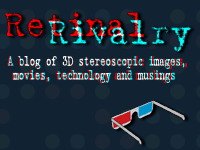In fact only one industry seemed to fall flat off the 3-D bandwagon - the camera companies.
 Panasonic was the only major player to show a 3-D video camera, and they are pricing it at $21,000! Fuji, of course, has their 1st gen 3-D still camera, but nobody else is joining that game - Canon's comment is "we're still investigating consumer needs." Even Sony, with their massive 3-D pavilion and live 3-D broadcasts in partnership with 3ality, had no answer regarding a consumer 3-D camera.
Panasonic was the only major player to show a 3-D video camera, and they are pricing it at $21,000! Fuji, of course, has their 1st gen 3-D still camera, but nobody else is joining that game - Canon's comment is "we're still investigating consumer needs." Even Sony, with their massive 3-D pavilion and live 3-D broadcasts in partnership with 3ality, had no answer regarding a consumer 3-D camera.3-D Bluray was all over the place, despite my strong belief that optical media is a dead-in-the-water format due to VOD and digital downloads. (A friend of mine calls 3-D the "defibrillator of Bluray") And DVD is dead - not a single 3-D DVD solution to be found anywhere. In fact, almost no support for existing home 3-D solutions. This all fuels my fear of a consumer backlash against 3-D at being told by the big corporations that they need to buy completely new hardware, both HDTVs and players to enjoy the coming 3-D age, especially after being forced to buy new HDTVs or digital tuners only a year ago.
The hope is that 3-D broadcasting will drive the market, and DirecTV has already announced both a Discovery 3-D Channel and ESPN 3-D. ESPN will launch their channel with worldwide 3-D coverage of the FIFA Soccer World Cup Championships in June - the largest single undertaking of live 3-D in history. The problem is that there will be a shortage of content in the immediate future to keep these 3-D channels "live". Hopefully, indie content producers like myself will be able to fill some of that void.
Which leads me to my observation that the Big Boys are missing a very important point. I attended a number of panels, and the "3D@Home Consortium" breakfast, where industry experts spoke of the future of home 3-D, both with rosy glasses (pun intended) and with a complete ignorance of the fact that independent content exists. Apparently, in the corporate vision of the future, only the major studios have the ability to produce viable 3-D movies and television programs, and they are missing the boat here. I stood up at the consortium breakfast, and asked why nobody was addressing what I see as the three 800-pound Gorillas in the room:
- first, that consumers will not be as eager to buy into a new technology if they can't create their own 3-D movies to view on that technology,
- Second, that there needs to be a distribution pathway for independent stereographic 3-D content to enter the game,
- and third, Youtube already delivers 3-D to the home via the beta player that has been active since last summer. Eventually, that player will finish it's beta stage, and any website will become a 3-D delivery platform via a simple embed. Most of the 3-D TVs on the show floor included direct Youtube streaming via WiFi as well. Now, Google owns Youtube, and Google has an OS that will be on millions of cellphones this year, also Youtube enabled. So, follow me here, Google is poised to become the LARGEST SINGLE AGGREGATOR AND DISTRIBUTOR of 3-D content in the world - both studio, indie and consumer produced content - and no one is talking about it.
I asked why Google was not invited to the table.
I left the consortium speechless.

2 comments:
I'm not sure I concur with the consumer argument. Consumers purchased HD sets long before consumer HD cameras were affordable, and of course watched TV long before there was a home camcorder.
However the chicken-and-egg is that there is currently no "unified" professional camera for creating stereoscopic content.
The "rigs" for two cameras are OK for filmmaking, but not for on-site television production. We need a camera than can be bumped and not get skewed. They need to be designed for fast shooting, not long set-ups. Plus an honest lens dealer will admit that they do not currently expect professional HD zoom lenses to be matched at all.
The Panasonic camera is the first step in "truly usable" stereoscopic 3D TV cameras.
The DVD Forum did name Sensio as an optional stereoscopic 3D technology in January. One could also use a "2D-compatible" coding (left/right, up/down, checkerboard) on DVD if one wanted to. But indeed, I'm not sure we will see any studios supporting 3D DVDs of any variety.
Good observation that Google may become the world's largest distributor of 3D video. There is a growing libary of 3D now available on Google and YouTube, although a majority of it is very bad quality 3D, or even non-3D, labeled as 3D using the yt3d tags.
I have been using a Minoru 3D webcam for broadcasting live 3D for a year at http://justin.tv/kq4ym and have uploaded lots of 3D to http://youtube.com/kq4ym and find this camera an inexpensive method to make 3D video and still photos.
Hopefully, more companies will produce good quality camera at reasonable prices for consumers like the Minoru 3D webcam.
Post a Comment